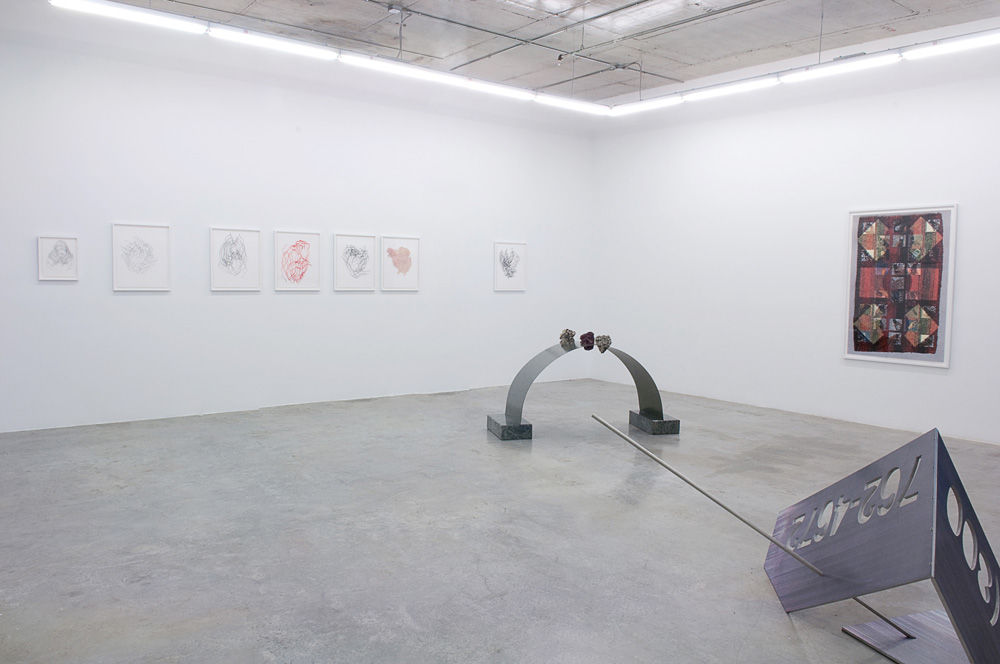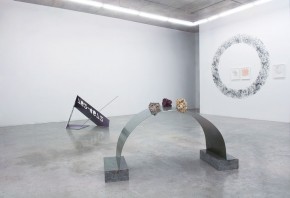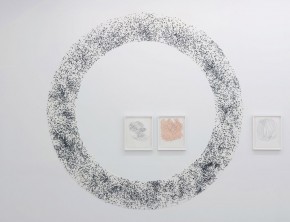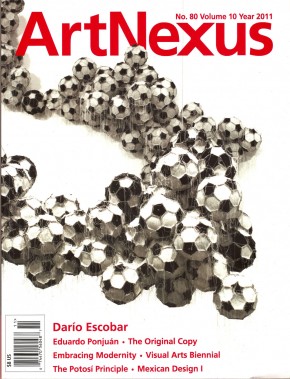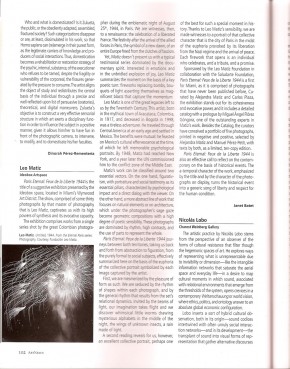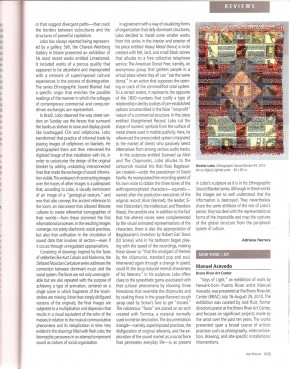Nicolas Lobo LIMESTONED
Charest-Weinberg is pleased to present LIMESTONED, an exhibition of new work by Nicolas Lobo. This will be the artist’s first solo presentation outside of a institutional venue.
In Stephen Baker’s recently published The Numerati, the business journalist corrals all of the data-harvesters, quant-jocks, and super-crunchers – pet names for the fledgling breed of info-junkies currently tracking your digital footsteps – into a single, aspirant professional class with the vaguely innocuous but kicky job title of “entrepreneurial mathematician.” Baker’s premise is simple: 1) The world is engaged in a massive project of quantification. 2) The impulse to quantify avalanches of blank information is practically instinctual. 3) The sheer mass of available information begs for its own analysis, rather than the specific qualities or attributes of that information.
Baker is smart to be wary about an immediate future driven by algorithms and administered by the cream of MIT. The endless subdividing of niches into ever more refined niches, he argues, surely improves the laser-like precision with which corporations currently micro-target a consumer – no surprise there. But Baker warns that we are, “in danger of becoming data-serfs – slaves to the information we produce.” In essence, we quantify information not for its social utility, nor even, for that matter, its commercial potential, but simply because it’s there.
Nicolas Lobo, a stalker of ascendant mega-trends in their embryonic rumor stage, would likely be amused by Baker’s alarmist wake-up call. Baker’s sinister future, after all, is already Lobo’s well-charted past. Raised in a Miami he describes as a “luxury laboratory” or “lifestyle incubator” where “Brand Ambassadors” test out new liquors with the measured politesse of Boutros Boutros-Gali, Lobo is not only no stranger to focus groups and direct marketing, he’s pleasantly habituated to the notion that he’s merely a statistic. That his preferences are tallied into numbers. That those numbers measure the probability that other, similar “Lobos,” or perhaps even subsequent generations of “Lobos” might share kindred tastes. Even when he’s being systematically depersonalized, Lobo doesn’t take it personally. He doesn’t have that luxury, so to speak, since his work depends on the excess energy thrown off by Baker’s enormous, implacable data-cloud.
Ergo, in answer to the pressing, if somewhat nebulous question: “What is Nicolas Lobo’s work about?” It’s fair to say that it concerns itself with the faint emanations from information systems and not information itself; with the vibrational frequencies of data and not any particular data-set; with the exhaust, fumes, and vapor trails left over from the numbers, and yet somehow not of the numbers in question. Information here – immaterial, spectral, evanescent – is like a white dwarf, the final evolutionary state of all stars whose mass is not high enough to become supernovae, or roughly 97% of the stars in our galaxy. Lobo’s subsequent alchemy of said info are the supernovae themselves – the other 3%.
Though sculptor is a descriptive term that seems to casually orbit around Lobo, when your primary aesthetic strategy, according to cultural theorist Gean Moreno, is to “give physical form to immaterial entities” — in effect, to sculpt invisibility itself — the notion of sculptor as practitioner is rendered instantly quaint. Just how quaint is readily apparent in Screwed Up Alvin and the Chipmunks (2010), an object whose inscrutable “thing-ness” more than captures Lobo’s entire hallucinated praxis. First, it bears mentioning that as an illustrative sculpture – that is, as an object that realistically approximates its titular subject matter — Screwed Up Alvin resembles the cuddly rodent trio to the same degree that Giacometti’s Woman With Her Throat Cut resembles an actual woman in extremis – which is to say, not at all.
Lobo, here, is interested in capturing the entire quantum wave of the Alvin phenomenon: the calendrical moment of the “band’s” conception, the ensuing genesis myth, the bizarre but temporary foothold on the collective American psyche, the Grammy’s and Christmas specials and sock-puppets and anthropomorphic plush toys, all the way through to their own pop cycle’s inevitable terminal stage where the group’s shrill, accelerated falsetto eclipses every extant cartoon, leaving only the historical residue of sound. That hopped-up, high-pitched wail, then — now shorn of its contextual backstory — is the invisible information – the material distillation, as it were – which Lobo then “sculpts” into physical form. This synaesthetic conjuring of irrepressible, two-dimensional, buck-toothed critters by a mere sonic fragment – a fragment which simultaneously embodies both 33 and 78 rpm — is a leitmotif that Lobo returns to again and again. My guess is that he begins with such absurdly esoteric source material as a means of gently priming us for the even more extreme distortions to come.
And come they do. If LIMESTONED as an exhibition title or thematic arc is to have any meaning at all, then that meaning resides in the fusion of the Classical block of stone – inert, mute, begging to be carved — and the appropriate state with which to stare contemplatively at said stone – slack-jawed, benumbed, obliquely associative. LIMESTONED, in other words, bears witness to the temporal collapse of archaic modes of construction with an altered perception in the viewer courtesy of modernity’s new-jack mood enhancers. So how, one might ask, does Lobo finesse this state of mind in the viewer for any meaningful duration? How does he attain escape velocity from the literal, the static, the traditional? And more importantly, does this customized mode of reverie in Lobo’s “New Now” come in tablet or gel cap form?
His solution is to push what was once a humble cartoon into the realm of over-the-top caricature. No easy task, you might think, given that the cartoon in question is already rocking an ensemble of monogrammed sweaters and Philip Johnson specs. Since caricature derives from the Italian “caricare” or “to load,” Lobo’s logical inclination is simply to hedge his bets and go for broke by overloading, or, more accurately, by exaggerating his subject matter up to the point where it is nearly unrecognizable. This process is additive, accumulative and the polar opposite of caricature’s less celebrated twin, the crazy uncle under the stairs otherwise known as defacement. Defacement, quite literally, is the removal of physical features through erasure, subtraction, and cancellation so as to prevent, delay, or otherwise disturb recognition. Alas, perhaps Lobo is indeed a “mathematical entrepreneur” given that caricature and defacement – flip sides of the same distorting coin – can be elegantly reduced to simple addition and subtraction.
So here, without further preamble, is the set-up for Screwed Up Alvin and the Chipmunks: In 1958 Ross Bagdasarian was down to his last $200 when he purchased a tape recorder allowing him to manipulate and vary tape speeds. Under the pseudonym David Seville, Bagdasarian soon had a #1 hit with the “Witch Doctor” featuring three chipmunk voices created by increasing the speed of audio tracks to get a distinctive, squeaky, high-pitched voice. Bagdasarian named the three Chipmunk characters after record executives: Simon Waronker, Theodore Keep, and Alvin Bennett.
Over 25 years later, in 1984, Robert Earl Davis Jr., later known as DJ Screw, began slowing down records in the privacy of his bedroom. DJ screw is famously credited with singlehandedly inventing Texas screw-music, a loose amalgam of gang anthems and pop and soul standards filtered through a slowed down drawl in order to match the drug induced haze of its listeners. Screw-music, simply put, is the antithesis of Alvin and the Chipmunks’ high-pitched serenades. Synonymous with purple cough syrup, Screw takes the form of a sound, a flavor, a color, a motion and a speed — the cultural experience as multi-sensory mash-up.
Now perhaps you see where Lobo is going with all this. You’ve already anticipated the stirring of biographical facts into the cauldron of roiling sub-cultural conditions. You cleverly intuit that a fusion of Screw’s lugubrious backbeat with the Chipmunks methyl-amphetamine doo-wop lyrics might lead to some, well…unexpected phenomenological reverb. Suddenly, it’s totally no surprise that Lobo is using three oolitic limestone rocks — chosen for their resemblance to Alvin, Theodore and Simon — and pickling them in grape cough syrup for several days until they retain a purplish glow and faint, grape Bubblicious smell. It all makes perfect sense. That gleaming formica arc which suspends the three anthropomorphic rocks while simultaneously suspending your disbelief is starting to look – dare I say it? — practically inevitable.
-David Hunt
Nicolas Lobo received his BFA from The Cooper Union in New York City in 2004. Born in Los Angeles, CA in 1979, he now lives and works in Miami, FL. He has had solo exhibitions at Twenty Twenty Projects and Locust Projects, both in Miami, FL. Additionally, Lobo’s work has been featured in numerous group exhibitions, including Space as Medium, Miami Art Museum; Night Shift, BASS Museum; The Possibility of an Island, MOCA, North Miami, FL; and On the Pleasure of Hating, Lisa Cooley Fine Art, New York, NY. Recently, he completed a book for [NAME] Publications, edited by Gean Moreno and published with the help of a grant from the John S. and James L. Knight Foundation. Concurrently, Nicolas Lobo’s work can be seen in the upcoming group exhibition at de la Cruz Collection, Miami, FL.
November 30th, 2010 - February 27th, 2011
Opening Reception: November 30th, 7PM

